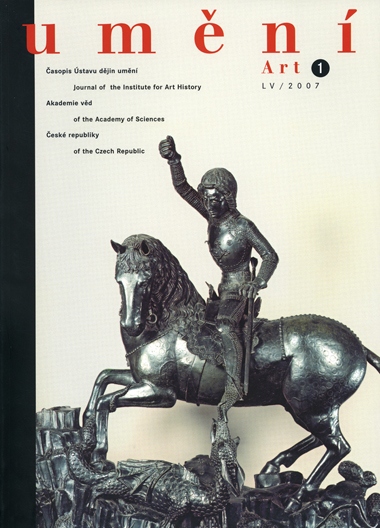Ivo Hlobil
Die tschechische Kunstforschung und die Bronzegruppe des hl. Georg auf der Prager Burg
The article responds to criticism of Czech art history expressed by major art historians abroad (Gerhard Schmidt, 1992, Ernő Marossi, 1999). They have charged that Czech research on the bronze sculpture of St George at Prague Castle, cast in 1373 by the brothers Martin and George of Klausenburg, has shown a patriotic bias. The first part of the article treats the view of Czech art historians of the early 20th century that the sculpture of St George was recast after 1562 and thereby changed in a Renaissance style, in particular the horse (Václav Vilém Štech-Zdeněk Wirth, 1913, Jaromír Pečírka, 1931, 1934 etc.). This view was predominant in the first half of the 19th century. Béla Lázár (1917) and Wilhelm Pinder (1924) did not agree. Albert Kutal (1949, 1962) and Viktor Kotrba (1962, 1969) put an end to these doubts. Yet neither mentioned that from the middle of the 19th century on, the founders of Czech art history, Ferdinand B. Mikovec, Karel Vladislav Zap and August Ambros, were convinced of the authenticity of this unique Gothic sculpture based on the basis of an analysis of mechanical damage. The second part of the article treats the view expressed by Albert Kutal (1949, 1962) that the Transylvanian metalworkers Martin and George of Klausenburg cast the sculpture of St George in 1373 according to a model by an anonymous sculpture from the Prague workshop of Peter Parler, as well as Jaromír Homolka's (1978, 1983) suggestion that Peter Parler designed the model. Unlike the abovementioned art historians, who fundamentally disagreed, the author of the article points out that the question as to whether or not the artistic draft of the sculpture originated in Prague is still serious and relevant. The recent uncovering of the original wall paintings on the staircase of the great tower at Karlštejn Castle (around 1365-1367) has confirmed the earlier observation (Vlasta Dvořáková, 1961, Albert Kutal, 1962) that the unusually vivid and anatomically accurate depiction of the horses there prefigured the statue of St George. Such a complex sculpture would have required a model, which, for stylistic reasons, must have been drawn in the 1360s. The person who drew the bronze statue of St George may have been inspired by classical and Italian sources in Bohemia, and not just in Italy. It may be identified as the potential work of Master Osvald, who probably painted the great part of the scenic miracles of St Wenceslas on the staircase of the great tower at Karlštejn and later also wall paintings in St Vitus Cathedral in Prague. There were woodcarvers and sculptors in Prague and Vienna who would have been able to construct a primary model and collaborate with the Transylvanian metalworkers on the wax model of this sculpture as well.
Full-text in the Digital Library of the Czech Academy of Sciences:
https://kramerius.lib.cas.cz/uuid/uuid:d2444aec-8d01-44b4-b3d1-9900c1b675d9
< back

